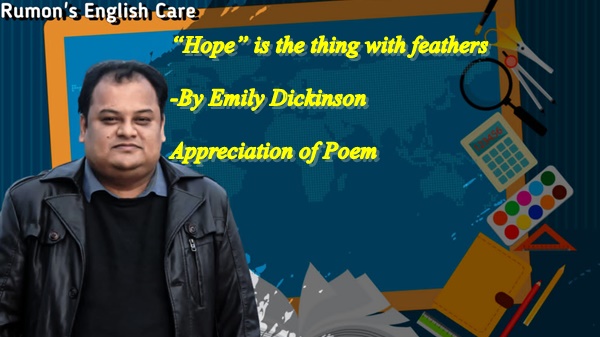“Hope” is the thing with feathers -By Emily Dickinson
“Hope” is the thing with feathers
-By Emily Dickinson
“Hope” is the thing with feathers –
That perches in the soul –
And sings the tune without the words –
And never stops – at all –
And sweetest – in the Gale – is heard –
And sore must be the storm –
That could abash the little Bird
That kept so many warm –
I’ve heard it in the chillest land –
And on the strangest Sea –
Yet – never – in Extremity,
It asked a crumb – of me.
Bengali Translation
”আশা” সে বস্তু পালক সহিত-
দাঁড়ে বসে সে যে মনে-
আর গুঁজন করে শব্দ ছাড়া-
থামে না কোনো ক্ষণে –
প্রবল বাতাসে, অতি মধুর- গান যার শোনা যায়
সেইতো রাকে মন অনেকের উদ্দীপ সহকারে।
নিদারুণ, অকরূণ ঝড়- নিশ্চিত হবে সে-
ছোট পাখিকে যে জেনো, কুন্ঠিত করিতে পারে।
শুনেছি আমি নিরুত্তাপ দেশে-
দূরবর্তী পৃথিবী- সমুদ্রপথে ঢেকে
তবু না কখন কোনোই প্রান্তে-
চেয়েছে কিছু সে পাখি- আমার থেকে।
a) Answer the following questions. 2×5=10
(i) Analysis of Emily Dickinson’s “Hope Is the Thing with Feathers”
(ii) Themes and Metaphors in “Hope is the Thing With Feathers” by Emily Dickinson
(iii) What does the gale symbolize in “Hope Is the Thing with Feathers”?
(iv) What does the gale symbolize in “Hope Is the Thing with Feathers”?
(v) Why is hope referred to as “the thing with feathers”?
b) Read the poem again, and identify 3 imageries and 2 similes used in the poem. Then explain the purpose of their uses. 10
c) Read the poem again and express your feelings. Or, Write the theme of the poem. 10
Answer:
(i) Analysis of Emily Dickinson’s “Hope Is the Thing with Feathers”
Ans: There are various different tones evident in Dickinson’s poem. At points the tone is defiant, reflective, and proud. In a poem comprising twelve lines, five lines begin with the word “and.” The repetition of sentences beginning with the word “and” helps to emphasize how many positive characteristics “Hope” has.
(ii) Themes and Metaphors in “Hope is the Thing With Feathers” by Emily Dickinson
Ans: In “Hope is the Thing With Feathers,” Emily Dickinson uses the metaphor of a bird to represent hope. The poem explores themes of resilience and perseverance, illustrating how hope persists even in difficult times. The bird sings continuously, symbolizing the enduring and uplifting nature of hope, which asks for nothing in return and remains a constant presence in the soul.
(iii) What does the gale symbolize in “Hope Is the Thing with Feathers”?
In “Hope Is the Thing with Feathers,” the gale symbolizes difficult times or feelings of anguish. Dickinson describes hope as a bird whose song is “sweetest – in the Gale,” indicating that hope is most appreciated and needed during life’s storms. Despite tumultuous circumstances, hope perseveres and continues to provide comfort and strength.
(iv) What does the gale symbolize in “Hope Is the Thing with Feathers”?
Ans: In “Hope Is the Thing with Feathers,” the gale symbolizes difficult times or feelings of anguish. Dickinson describes hope as a bird whose song is “sweetest – in the Gale,” indicating that hope is most appreciated and needed during life’s storms. Despite tumultuous circumstances, hope perseveres and continues to provide comfort and strength.
(v) Why is hope referred to as “the thing with feathers”?
Ans: Hope is referred to as “the thing with feathers” because it is compared to a bird in Emily Dickinson’s poem. This metaphor suggests that hope, like a bird, perches in the soul and sings continuously, even in the darkest moments. It symbolizes that hope is always present, resilient through hardships, and asks nothing in return.
(vi) What is an important characteristic of hope?
Ans: An important characteristic of hope, as depicted in Dickinson’s poem, is its steadfastness. Hope endures and is at its strongest during difficult circumstances. Additionally, hope is courageous, as it remains unshaken by adversity, and noble, as it provides support without asking for anything in return.
(vii) What does hope ask for in return in “Hope Is the Thing with Feathers”?
In “Hope Is the Thing with Feathers,” hope asks for nothing in return. Emily Dickinson uses an extended metaphor to describe hope as a bird that resides in the human soul, providing strength and perseverance without ever demanding anything back, even in the most difficult times.
(viii) Why does Emily Dickinson use the bird image in poem “254”?
Ans: Emily Dickinson uses the bird image in poem “254” as an extended metaphor for hope. The bird, without being explicitly named, represents hope’s persistent and uplifting presence within the soul. It perches in the heart, singing continually, especially during life’s storms, symbolizing resilience and optimism. The bird’s song, a metaphor for hope, costs nothing yet provides essential purpose and strength, illustrating hope’s vital role in human endurance and spirit.
Summary:
The poem ‘Hope is the Thing with Feathers’ by Emily Dickinson explores the concept of hope as a resilient and unremitting force. The speaker compares hope to a bird that lives in the soul, singing a wordless tune that lasts regardless of circumstances.
Theme:
Hope The primary theme of “‘Hope’ is the Thing with Feathers” is endless hope. Dickinson emphasizes hope lives in one’s soul forever and empowers and propels us to endure whatever life presents.
Metaphor: There is one extended metaphor in the poem. Dickenson has compared hope with “feathers”/ “bird” which shows how it sings and gives courage to the spirit of a person.
Imagery: Imagery is used to make the readers perceive things through the five senses. It helps them to create a mental picture of the objects described. The poet has used images for the sense of sight such as “bird”, “feathers”, “storm”, “land” and “sea.”
Symbol: Emily has used many symbols to show the powerful impact of hope in our lives. “Chilliest Sea” and “storm” symbolize struggles during trying times when hope is still there.

